A Simple Method for Solving the Power Fluctuation Issue of a Base Station’s Surrounding Areas Based on Half Tyler Distribution
Abstract
:1. Introduction
2. HT Distribution and Simulation Results
2.1. Elements and Linear Array
2.2. HT Feed Network Design of a Linear Array
2.3. M × N Planar Array
3. Measurement
4. Conclusions
Author Contributions
Funding
Data Availability Statement
Conflicts of Interest
References
- Zhao, G.; Chen, S.; Zhao, L.; Hanzo, L. Energy-Spectral-Efficiency Analysis and Optimization of Heterogeneous Cellular Networks: A Large-Scale User-Behavior Perspective. IEEE Trans. Veh. Technol. 2018, 67, 4098–4112. [Google Scholar] [CrossRef]
- Benzaghta, M.; Rabie, K.M. Massive MIMO Systems for 5G: A Systematic Mapping Study on Antenna Design Challenges and Channel Estimation Open Issues. IET Commun. 2021, 15, 1677–1690. [Google Scholar] [CrossRef]
- Woodward, P.M. A Method for Calculating the Field over a Plane Aperture Required to Produce a Given Polar Diagram. J. IEE 1946, 93, 1554–1558. [Google Scholar] [CrossRef]
- Woodward, P.M.; Lawson, J.D. The Theoretical Precision with Which an Arbitrary Radiation-Pattern May be Obtained from a Source of a Finite Size. J. IEE 1948, 95, 363–370. [Google Scholar]
- Orchard, H.J.; Elliott, R.S.; Stern, G.J. Optimising the Synthesis of Shaped Beam Antenna Patterns. J. IEE Proc. 1985, 132, 63–68. [Google Scholar] [CrossRef]
- Bai, Y.; Liang, Z.; Zhai, C.; Xin, Y.; Li, W. Joint Precoding Using Successive Over-relaxation Matrix Inversion and Newton Iteration for Massive MIMO Systems. In Proceedings of the 2019 11th International Conference on Wireless Communications and Signal Processing (WCSP), Xi’an, China, 23–25 October 2019; pp. 1–5. [Google Scholar] [CrossRef]
- Lindmark, B. Analysis of pattern null-fill in linear arrays. In Proceedings of the 2013 7th European Conference on Antennas and Propagation (EuCAP), Gothenburg, Sweden, 8–12 April 2013; pp. 1457–1461. [Google Scholar]
- Elliott, R.; Stern, G. A new technique for shaped beam synthesis of equispaced arrays. IEEE Trans. Antennas Propag. 1984, 32, 1129–1133. [Google Scholar] [CrossRef]
- Yamamoto, M.; Arai, H.; Ebine, Y.; Nasuno, M. Simple design of null-fill for linear array. In Proceedings of the 2016 International Symposium on Antennas and Propagation (ISAP), Okinawa, Japan, 24–28 October 2016; pp. 410–411. [Google Scholar]
- Yamamoto, M.; Arai, H.; Ebine, Y.; Nasuno, M. Simple design method for cosec square with null-fill in equispaced linear array. In Proceedings of the 2017 International Workshop on Electromagnetics: Applications and Student Innovation Competition, London, UK, 30 May–1 June 2017; pp. 160–161. [Google Scholar] [CrossRef]
- Ahangiri, M.; Kaboli, M.; Mirtaheri, S.A. Design Beamforming Network of Linear Array for Base Station Antennas at 1.71–2.69 GHz by Using Genetic Algorithm. In Proceedings of the Electrical Engineering (ICEE), Iranian Conference on, Mashhad, Iran, 8–10 May 2018; pp. 621–626. [Google Scholar] [CrossRef]
- Zaharis, Z.D.; Lazaridis, P.I.; Cosmas, J.; Skeberis, C.; Xenos, T.D. Synthesis of a Near-Optimal High-Gain Antenna Array with Main Lobe Tilting and Null Filling Using Taguchi Initialized Invasive Weed Optimization. IEEE Trans. Broadcast. 2014, 60, 120–127. [Google Scholar] [CrossRef]
- Chen, Z.; Song, Z.; Liu, H.; Yu, J.; Chen, X. Passive-Shaped Beam Synthesis Using Pattern Diversity Dielectric Resonator Antenna Array. IEEE Antennas Wirel. Propag. Lett. 2021, 20, 1115–1119. [Google Scholar] [CrossRef]
- Shin, D.-H.; Kim, K.-B.; Kim, J.-G.; Park, S.-O. Design of Null-Filling Antenna for Automotive Radar Using the Genetic Algorithm. IEEE Antennas Wirel. Propag. Lett. 2014, 13, 738–741. [Google Scholar] [CrossRef]
- Lazaridis, P.I.; Tziris, E.; Zaharis, Z.D.; Xenos, T.; Holmes, V.; Cosmas, J.P.; Glover, I.A. Comparative study of broadcasting antenna array optimization using evolutionary algorithms. In Proceedings of the 2016 URSI Asia-Pacific Radio Science Conference (URSI AP-RASC), Seoul, Republic of Korea, 21–25 August 2016; pp. 1299–1301. [Google Scholar] [CrossRef]
- Hirokawa, J.; Yamazaki, C.; Ando, M. Postwall waveguide slot array with cosecant radiation pattern and null filling for base station antennas in local multidistributed systems. Radio Sci. 2002, 37, 1–7. [Google Scholar] [CrossRef]
- Nawaz, H.; Liang, X.; Sadiq, M.S.; Geng, J.; Zhu, W.; Jin, R. Ruggedized Planar Monopole Antenna with a Null-Filled Shaped Beam. IEEE Antennas Wirel. Propag. Lett. 2018, 17, 933–936. [Google Scholar] [CrossRef]
- Kim, W.; Shin, G.; Lee, K.-W.; Mun, B.; Yoon, I.-J. A Wideband Monoconical Antenna for Airborne Applications with a Null-Filled Radiation Pattern. IEEE Antennas Wirel. Propag. Lett. 2022, 21, 1158–1162. [Google Scholar] [CrossRef]
- Sadiq, M.S.; Ullah, S.; Ruan, C.-J. Null-filled Shaped Beam Horizontally Polarized Omnidirectional Antenna. In Proceedings of the 2019 Photonics & Electromagnetics Research Symposium-Fall (PIERS-Fall), Xiamen, China, 17–20 December 2019; pp. 464–469. [Google Scholar] [CrossRef]
- Ye, L.H.; Cao, Y.F.; Zhang, X.Y.; Gao, Y.; Xue, Q. Wideband Dual-Polarized Omnidirectional Antenna Array for Base-Station Applications. IEEE Trans. Antennas Propag. 2019, 67, 6419–6429. [Google Scholar] [CrossRef]
- Nawaz, H.; Liang, X.; Sadiq, M.S.; Geng, J.; Jin, R. Circularly-Polarized Shaped Pattern Planar Antenna for Aerial Platforms. IEEE Access 2020, 8, 7466–7472. [Google Scholar] [CrossRef]
- Diao, W.; Li, Y.; Zhang, Z. A Null-Filled Axisymmetric Secant-Square-Shaped Beam Antenna for Unmanned Aerial Vehicles. IEEE Antennas Wirel. Propag. Lett. 2023, 22, 1937–1941. [Google Scholar] [CrossRef]
- Dash, J.C.; Kalva, N.; Kharche, S.; Mukherjee, J. Isolation Enhancement of Closely Spaced MIMO System Using Inverted Fork Shaped Decoupling Structure. In Proceedings of the 2020 14th European Conference on Antennas and Propagation (EuCAP), Copenhagen, Denmark, 15–20 March 2020; pp. 1–3. [Google Scholar] [CrossRef]
- Zhang, Y.; Zhang, X.Y.; Ye, L.-H.; Pan, Y.-M. Dual-Band Base Station Array Using Filtering Antenna Elements for Mutual Coupling Suppression. IEEE Trans. Antennas Propag. 2016, 64, 3423–3430. [Google Scholar] [CrossRef]
- Gu, L.; Yang, W.; Liao, S.; Xue, Q.; Che, W. Novel Coupling Cancellation Method by Loading Planar Path for Wideband High-Isolation Wide-Scanning Millimeter-Wave Phased Array. IEEE Trans. Antennas Propag. 2022, 70, 10520–10530. [Google Scholar] [CrossRef]
- Scattone, F.; Ettorre, M.; Eddo, B.; Sauleau, R.; Fonseca, N.J.G. Truncated Leaky-Wave Antenna with Cosecant-Squared Radiation Pattern. IEEE Antennas Wirel. Propag. Lett. 2018, 17, 841–844. [Google Scholar] [CrossRef]
- Henderson, K.Q.; Ghalichechian, N. Triangular and Rectangular Lattices for Cosecant-Squared-Shaped Beam Reflectarrays. IEEE Antennas Wirel. Propag. Lett. 2021, 20, 2058–2062. [Google Scholar] [CrossRef]
- Chu, H.; Li, P.; Guo, Y.-X. A Beam-Shaping Feeding Network in Series Configuration for Antenna Array with Cosecant-Square Pattern and Low Sidelobes. IEEE Antennas Wirel. Propag. Lett. 2019, 18, 742–746. [Google Scholar] [CrossRef]
- Trzebiatowski, K.; Kalista, W.; Rzymowski, M.; Kulas, Ł.; Nyka, K. Multibeam Antenna for Ka-Band CubeSat Connectivity Using 3-D Printed Lens and Antenna Array. IEEE Antennas Wirel. Propag. Lett. 2022, 21, 2244–2248. [Google Scholar] [CrossRef]
- Nasr, A.M.H.; Sarabandi, K. A Low-Cost Millimeter-Wave 5G V2X Multi-Beam Dual-Polarized Windshield Antenna. IEEE Open J. Antennas Propag. 2022, 3, 1313–1323. [Google Scholar] [CrossRef]
- Zhang, C.; Peng, Y. Received Antenna Array Design of GSSK-Based Antennas Selection for RIS-Assisted Communication. IEEE Syst. J. 2023, 17, 3366–3369. [Google Scholar] [CrossRef]
- Liu, Y.; Kelly, J.; Holm, M.; Gopal, S.; Aghdam, S.R.; Liu, Y. Unit Cell Design for Intelligent Reflecting and Refracting Surface (IRS) with Independent Electronic Control Capability. IEEE Antennas Wirel. Propag. Lett. 2024, 23, 414–418. [Google Scholar] [CrossRef]
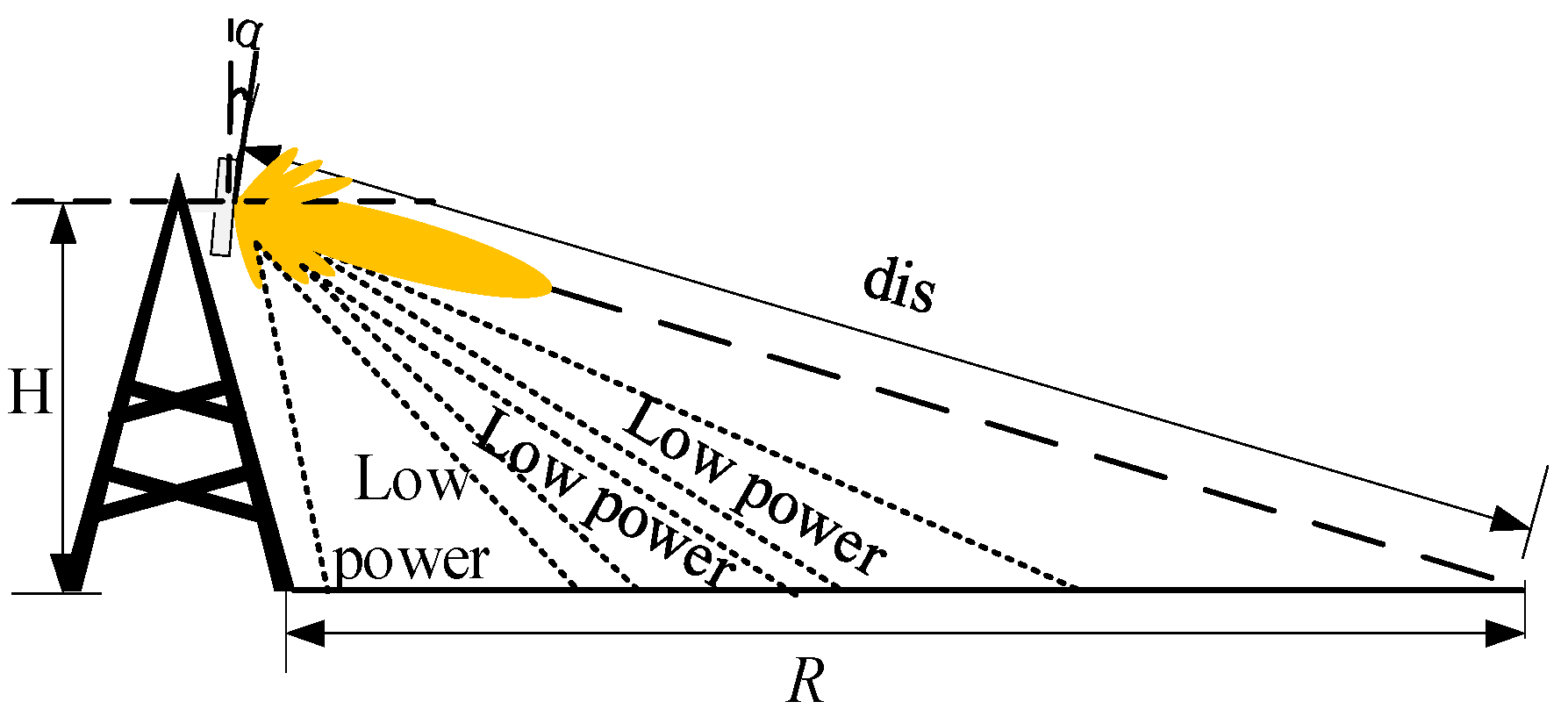
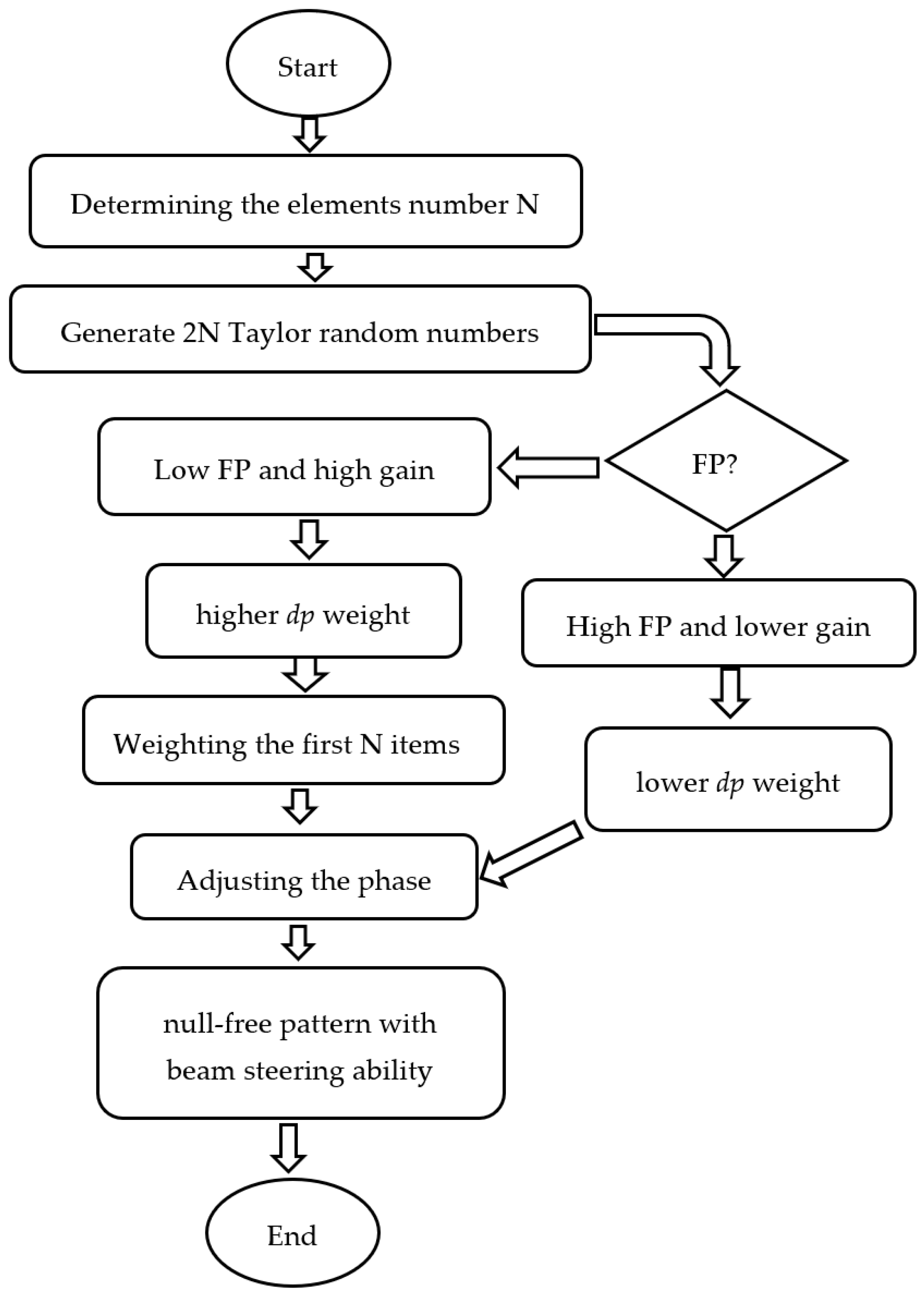

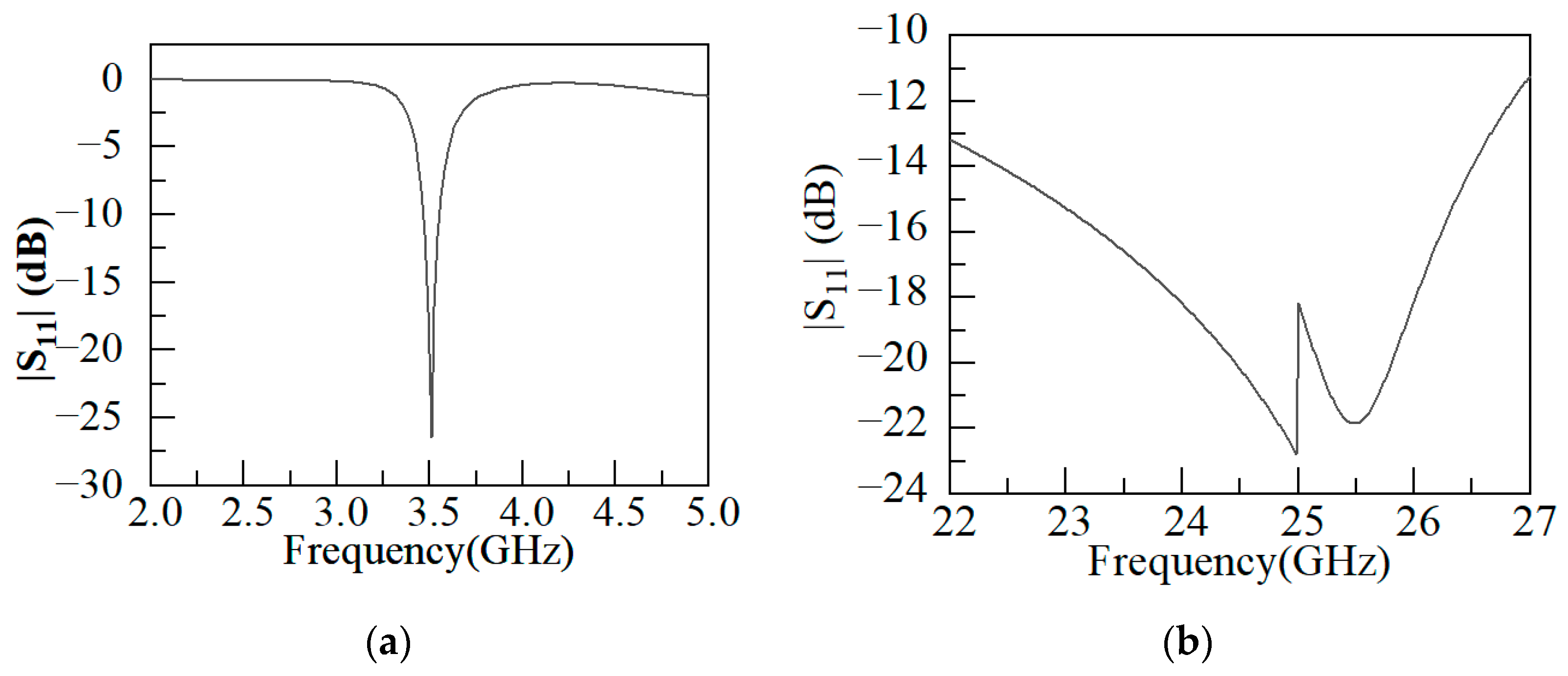


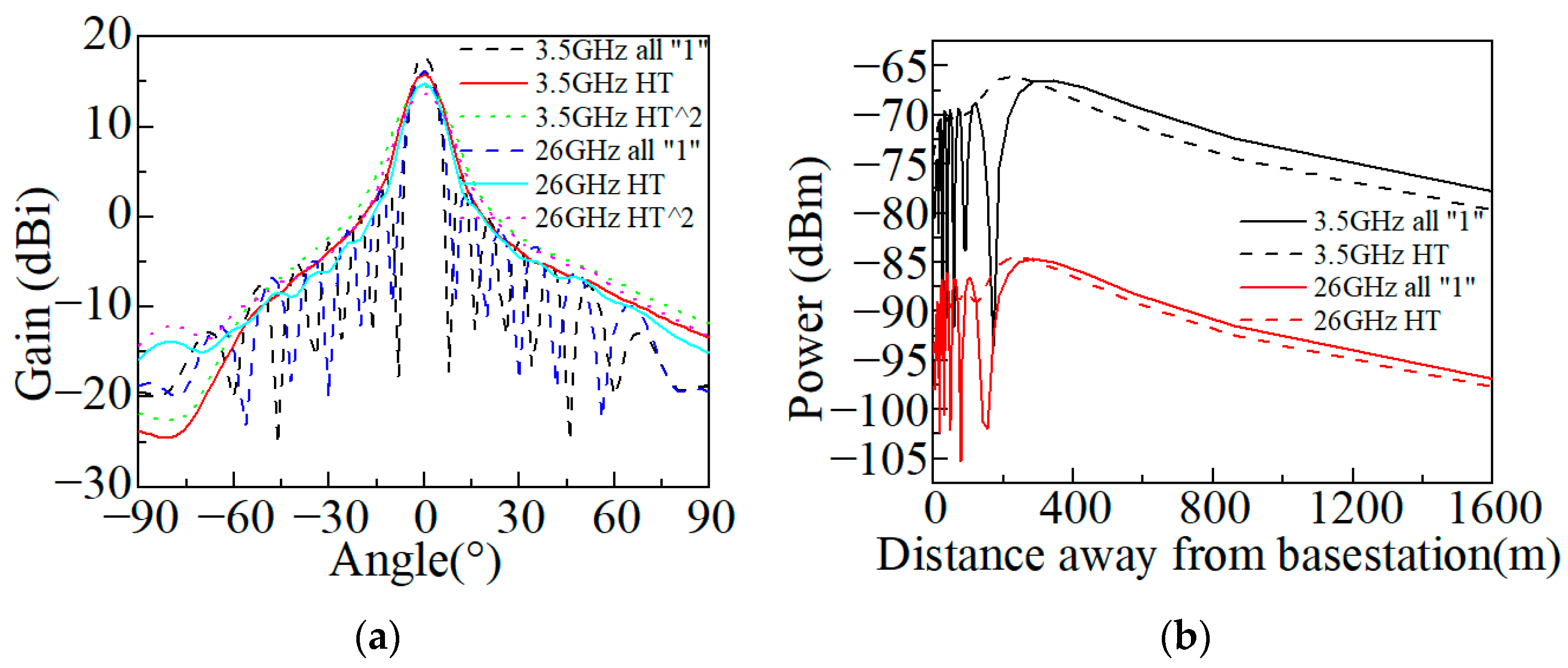
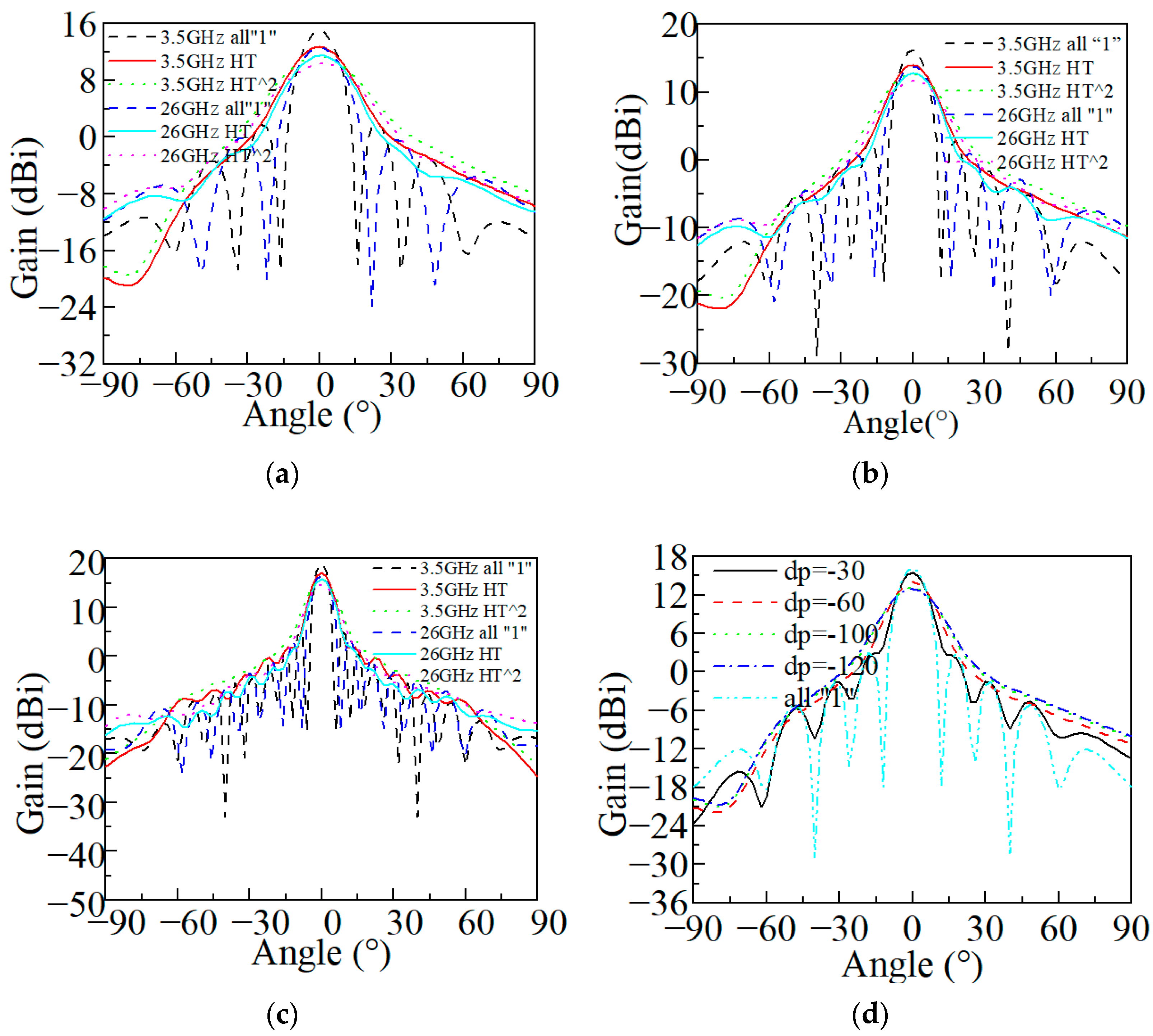
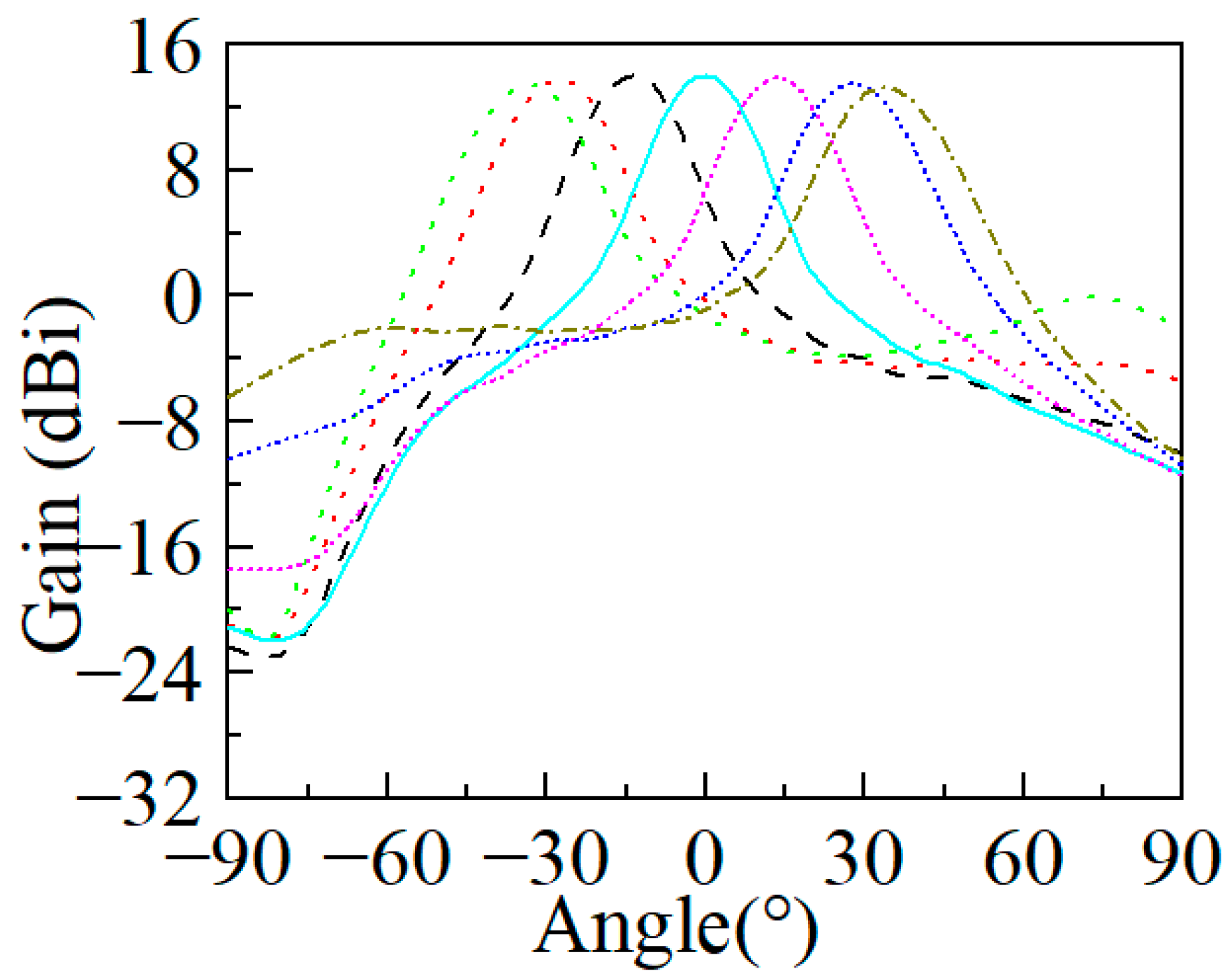
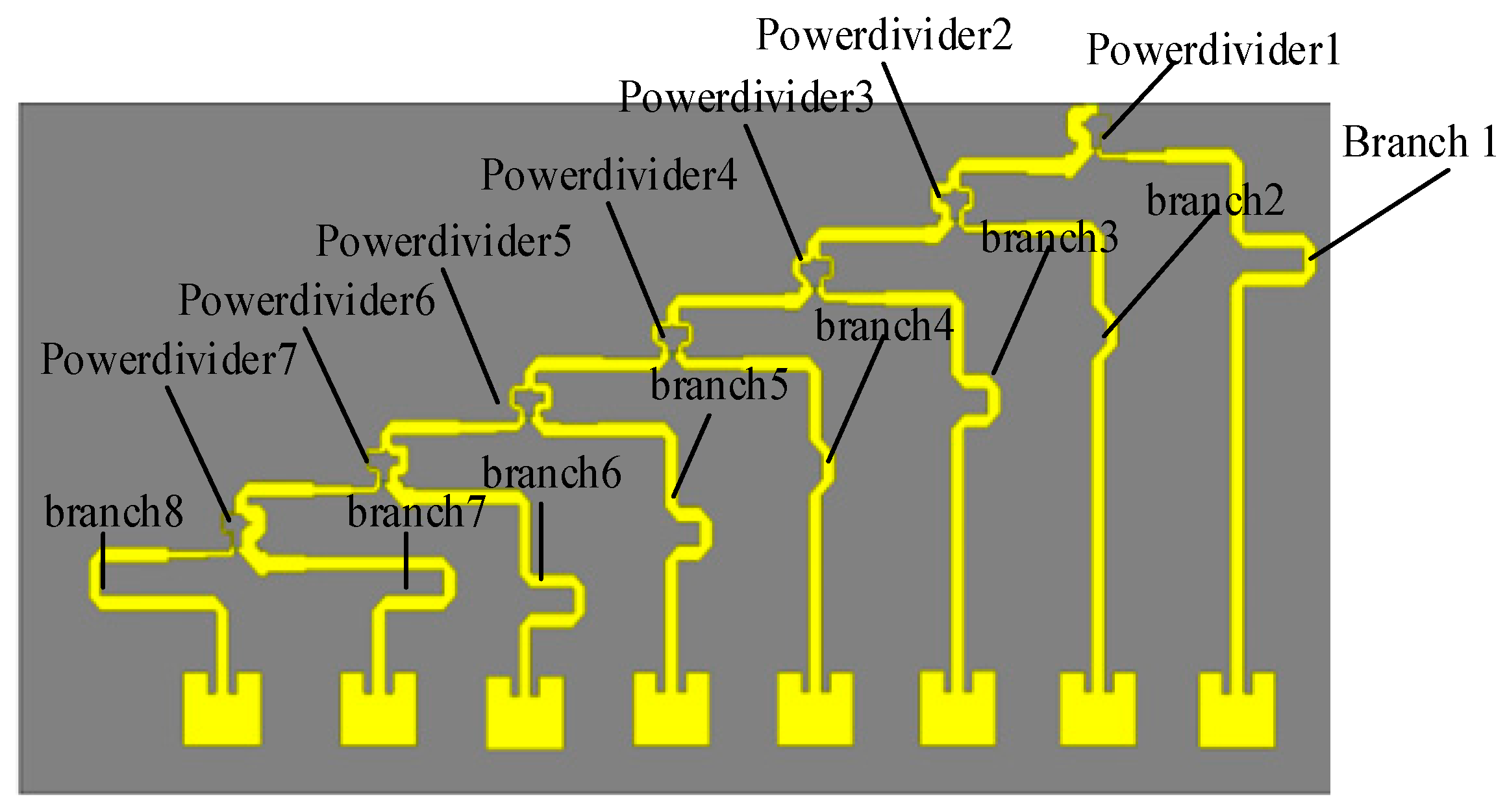
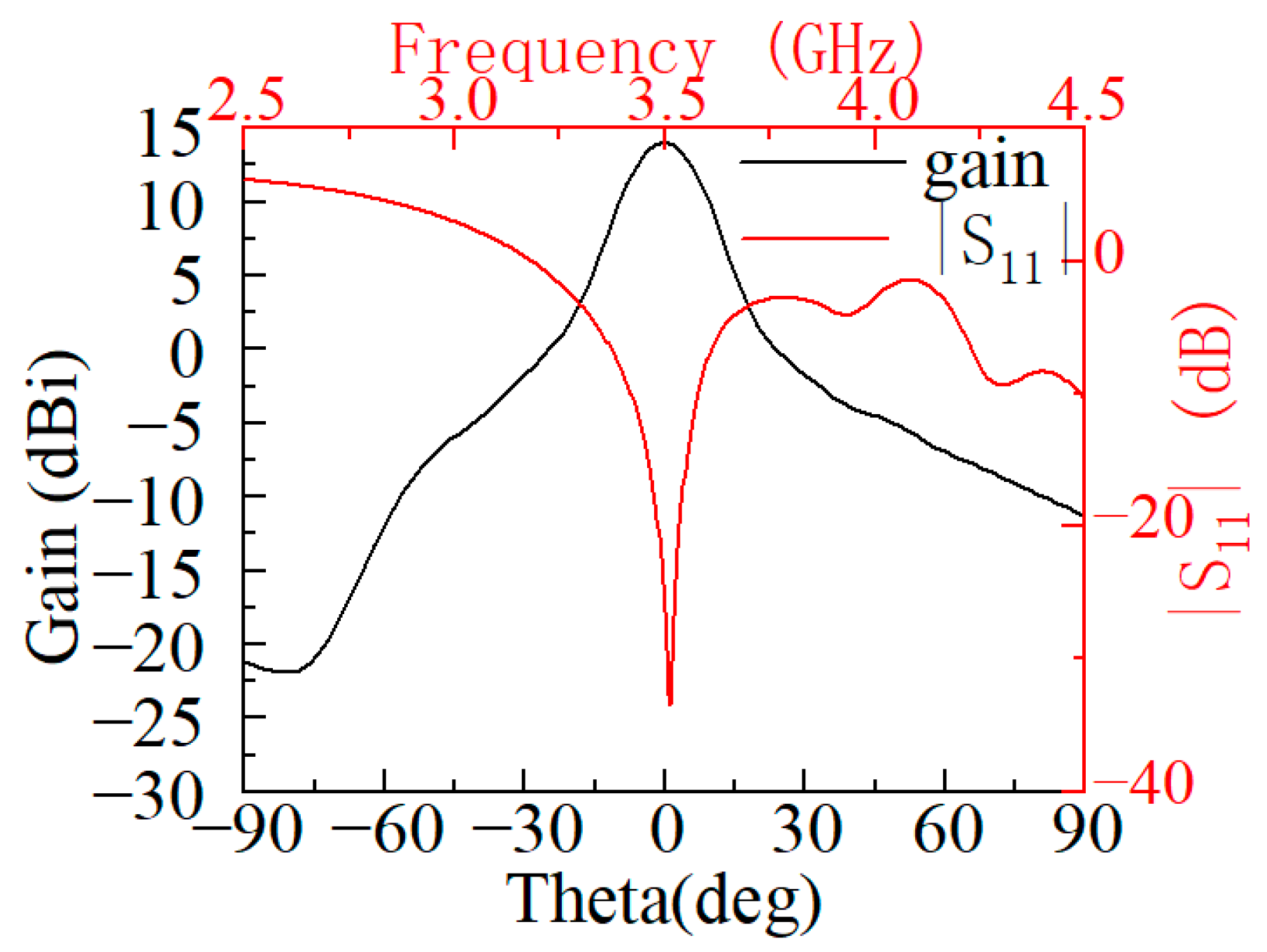

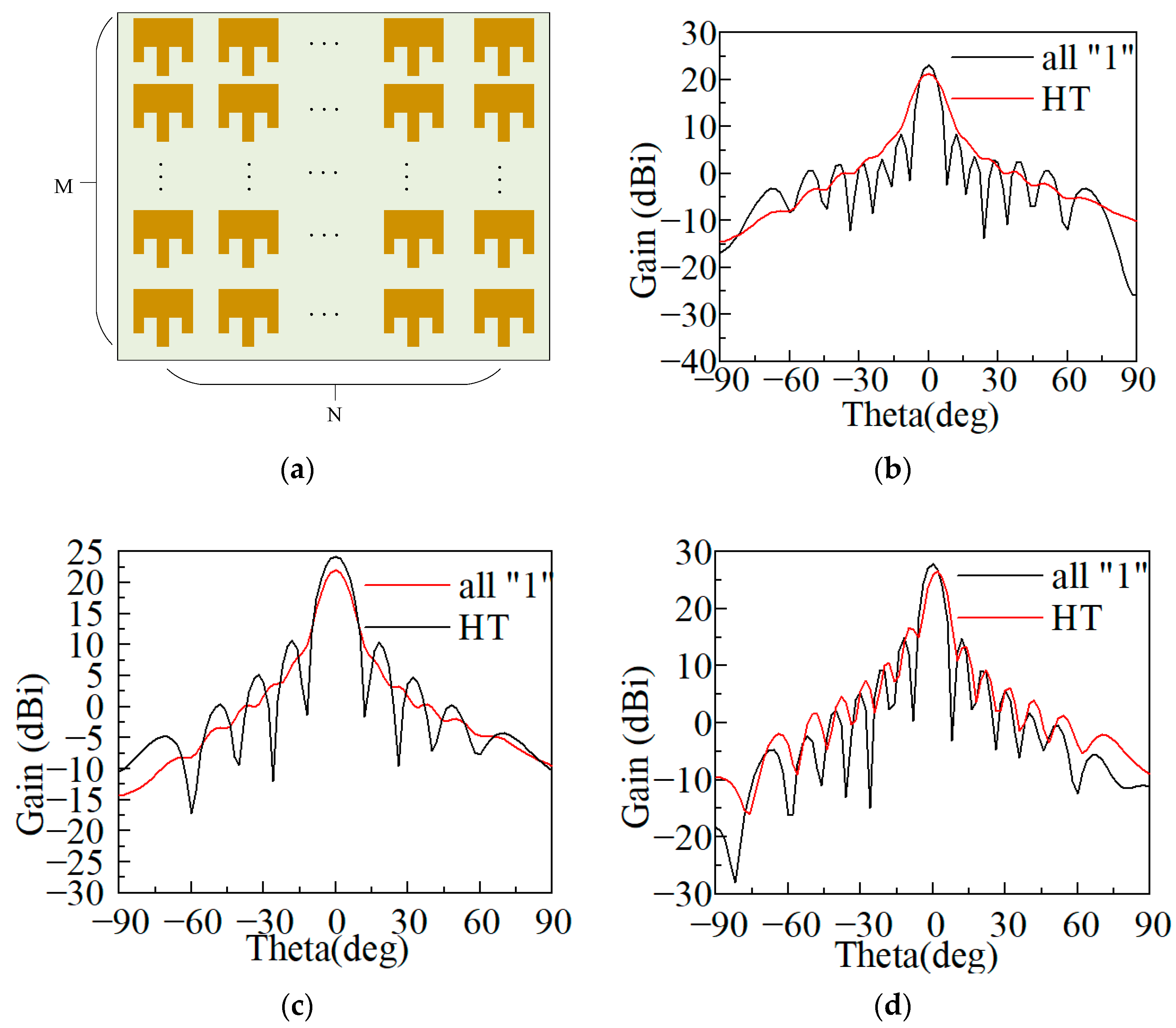
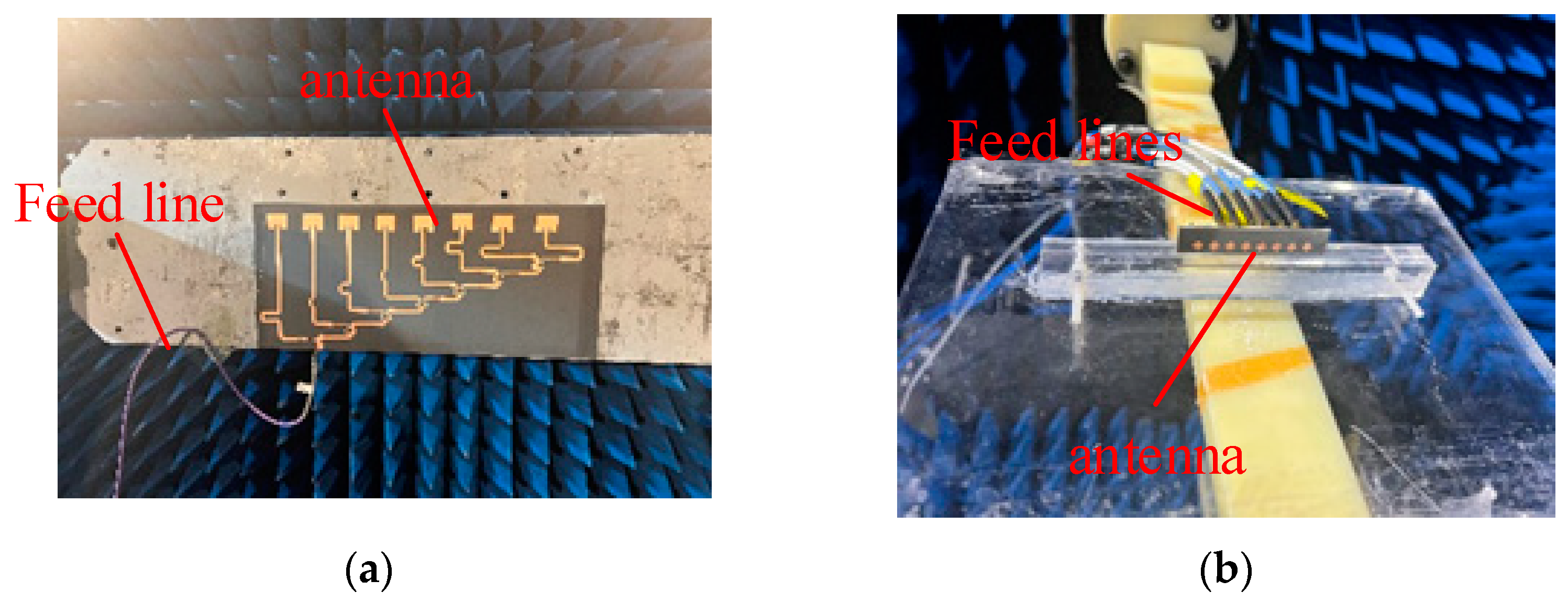
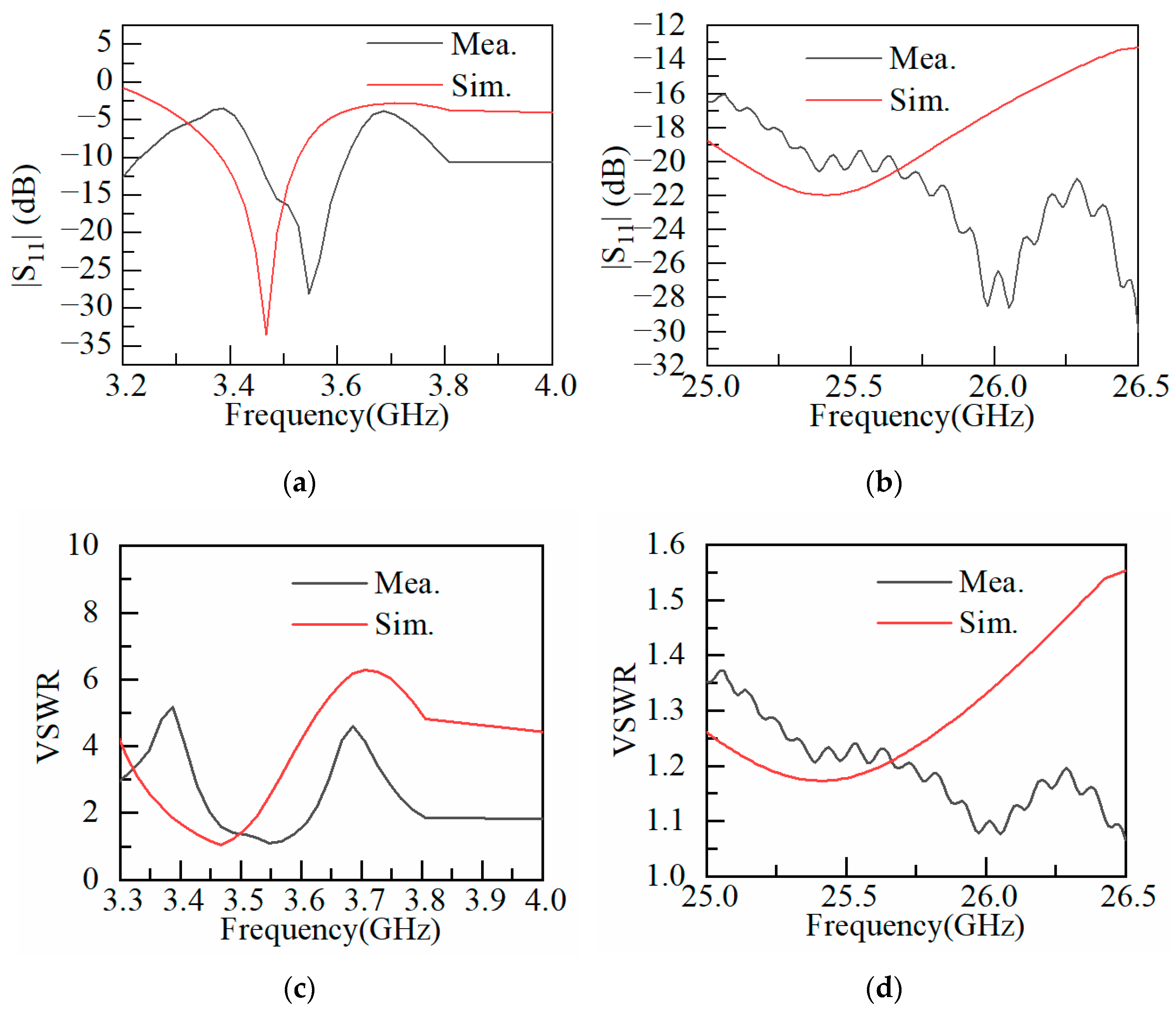

| N | 1 | 2 | 3 | 4 | 5 | 6 | 7 | 8 |
| 6 | 0.02 | 0.081 | 0.25 | 0.517 | 0.808 | 1 | ||
| 8 | 0.02 | 0.053 | 0.144 | 0.293 | 0.492 | 0.707 | 0.892 | 1 |
| 12 | 0.02 | 0.034 | 0.074 | 0.138 | 0.226 | 0.338 | 0.469 | 0.609 |
| 16 | 0.02 | 0.028 | 0.05 | 0.086 | 0.135 | 0.198 | 0.273 | 0.362 |
| N | 9 | 10 | 11 | 12 | 13 | 14 | 15 | 16 |
| 12 | 0.746 | 0.856 | 0.953 | 1 | ||||
| 16 | 0.459 | 0.562 | 0.666 | 0.764 | 0.852 | 0.923 | 0.974 | 1 |
| Paper/Year | Method | Complexity | Far-Field Pattern | Beam Scanning |
|---|---|---|---|---|
| [7]/2013 | Schelkunoff roots | high | Null-filled | \ |
| [12]/2014 | TI-IWOA | high | Filling 1 null | \ |
| [13]/2021 | DRA and AFSA | high | Arbitrary | yes |
| [14]/2014 | GA | high | Null-filled | no |
| [23]/2020 | Decoupling structure | high | Null-filled | no |
| [24]/2016 | Complex control | high | Filling 1 null | \ |
| [25]/2022 | Coupling cancellation | high | Existing nulls | ±60° |
| This work | HT method | low | Null-free | ±42° |
Disclaimer/Publisher’s Note: The statements, opinions and data contained in all publications are solely those of the individual author(s) and contributor(s) and not of MDPI and/or the editor(s). MDPI and/or the editor(s) disclaim responsibility for any injury to people or property resulting from any ideas, methods, instructions or products referred to in the content. |
© 2024 by the authors. Licensee MDPI, Basel, Switzerland. This article is an open access article distributed under the terms and conditions of the Creative Commons Attribution (CC BY) license (https://creativecommons.org/licenses/by/4.0/).
Share and Cite
Duan, L.; Zhang, J.; Zhu, X.; Zhang, Y.; Chang, D.; Dong, J.; Zhang, X. A Simple Method for Solving the Power Fluctuation Issue of a Base Station’s Surrounding Areas Based on Half Tyler Distribution. Electronics 2024, 13, 725. https://doi.org/10.3390/electronics13040725
Duan L, Zhang J, Zhu X, Zhang Y, Chang D, Dong J, Zhang X. A Simple Method for Solving the Power Fluctuation Issue of a Base Station’s Surrounding Areas Based on Half Tyler Distribution. Electronics. 2024; 13(4):725. https://doi.org/10.3390/electronics13040725
Chicago/Turabian StyleDuan, Lifeng, Jinling Zhang, Xiongzhi Zhu, Yu Zhang, Dunyu Chang, Jiaqi Dong, and Xiaoxian Zhang. 2024. "A Simple Method for Solving the Power Fluctuation Issue of a Base Station’s Surrounding Areas Based on Half Tyler Distribution" Electronics 13, no. 4: 725. https://doi.org/10.3390/electronics13040725





